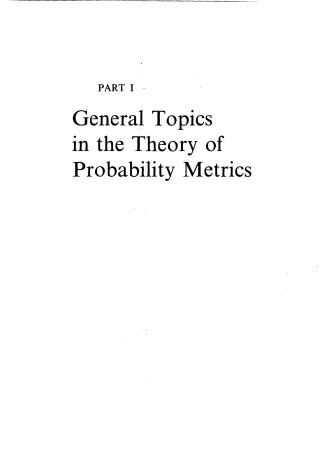Probability & Mathematical Statistics S.
1 total work
Probability Metrics and the Stability of Stochastic Models
by Svetlozar T. Rachev
Published 20 March 1991
In probability theory, metrics have been used for a long time, although one usually exploits a very limited class of metrics. Also, some ideas of the method of metric distances (MMD) have been used for a long time in approximation theory and functional analysis. In view of the variety of stability problems, there are no regular selection rules determining the "ideal" metric for the given problem. Therefore, the development of the MMD demands the creation of a theory of probability metrics (TPM). The term "probability metric" means simply a semimetric in a space of random variables, taking values in some separable metric space. In probability theory, sample spaces are usually not fixed and one is interested in those metrics whose values depend on the joint distributions of the pairs of random variables being considered. Each such metric can be considered just as given by a function defined on the set of probability measures on the Cartesian square of the sample space. The necessary classification of the set of probability metrics (p. metrics) is naturally carried out from the point of view of metric structure and generating topologies.
That is why the following two research directions arise: description of the basic structure of p. metrics; analysis of the topologies in the space of probability measures, generated by different types of p. metrics. This analysis can be carried out with the help of convergence criteria for different metrics; characterization of the ideal metrics for the given problem; and investigations of the main relationship between different types of p. metrics. In this book, all four research directions are considered as well as applications to different problems of probability theory. Much attention is paid to the possibility of giving equivalent definitions of p. metrics. Indeed, in concrete applications of p. metrics, the use of different equivalent variants of the definitions in different steps of the proof is often a decisive factor. One of the main classes of metrics considered is the class of minimal metrics, the idea of which goes back to the work of Kantorovich in the 1940's on the transportation problems in linear programming. Such metrics have been found independently by many authors in several parts of probability theory.
The MMD given herein is illustrated in some concrete problems. First, there are problems of the type of the Glivenko-Cantelli theorem on the convergence of the empirical measures. Analogously, the author considers a generalization of the Prokhorov theorem on convergence of random polygons to the Wiener process in the case where one considers the question of convergence of distributions of unbounded functionals. Also considered are applications to the rate of convergence for sums and maxima of random variables and convolution of random motions. Special sections are devoted to application of TPM to the solution of stability problems in queueing theory, risk theory, quality usage, and others.
That is why the following two research directions arise: description of the basic structure of p. metrics; analysis of the topologies in the space of probability measures, generated by different types of p. metrics. This analysis can be carried out with the help of convergence criteria for different metrics; characterization of the ideal metrics for the given problem; and investigations of the main relationship between different types of p. metrics. In this book, all four research directions are considered as well as applications to different problems of probability theory. Much attention is paid to the possibility of giving equivalent definitions of p. metrics. Indeed, in concrete applications of p. metrics, the use of different equivalent variants of the definitions in different steps of the proof is often a decisive factor. One of the main classes of metrics considered is the class of minimal metrics, the idea of which goes back to the work of Kantorovich in the 1940's on the transportation problems in linear programming. Such metrics have been found independently by many authors in several parts of probability theory.
The MMD given herein is illustrated in some concrete problems. First, there are problems of the type of the Glivenko-Cantelli theorem on the convergence of the empirical measures. Analogously, the author considers a generalization of the Prokhorov theorem on convergence of random polygons to the Wiener process in the case where one considers the question of convergence of distributions of unbounded functionals. Also considered are applications to the rate of convergence for sums and maxima of random variables and convolution of random motions. Special sections are devoted to application of TPM to the solution of stability problems in queueing theory, risk theory, quality usage, and others.
